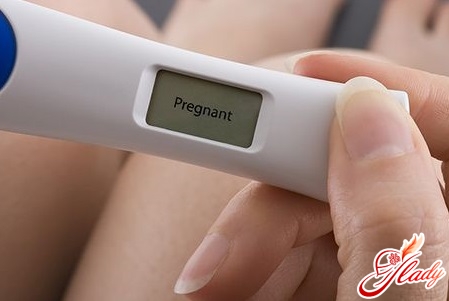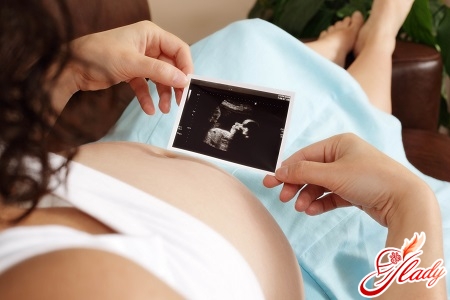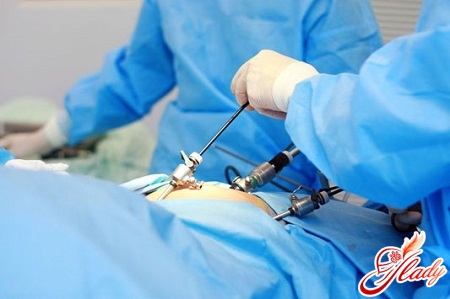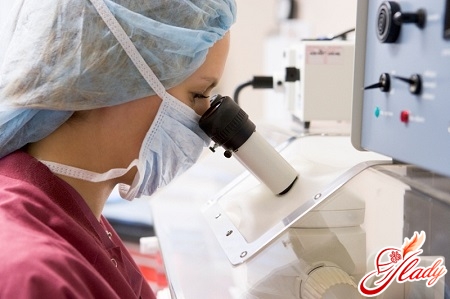
We live in a civilized and high-techXXI century. Today, when no one is surprised at Skype communication and space tourism, some women continue to remain ignorant about pregnancy planning. In order to speed up the process of conception of the baby or, conversely, in order to prevent an undesirable pregnancy, learn how to correctly calculate the moment of ovulation (fertile phase) and study its main signs. Ovulation and conception are two processes that are inextricably linked to each other.
Phases of the monthly cycle
Conceive child without ovulationit is impossible, therefore, any woman dreaming of an heir should learn to calculate with accuracy the days that are favorable for the birth of a new life in her organism. Ovulation can be called the main event of the menstrual cycle, during which the egg ready for fertilization enters the abdominal cavity from the ovarian follicle. If the egg in this period merges with the spermatozoon, there will be a conception. Otherwise, after some time, she will leave the female body with blood. The menstrual cycle can be divided into 3 periods:
- relative sterility (fertilization is permissible, but it may not occur);
- fertility (the most suitable period for conception);
- absolute sterility (when conception can not occur).
Relative sterility occurs in the period fromthe last for the monthly and lasts about 14 days (until the moment of ovulation). The chances of getting pregnant these days are not high, but they still exist and many women managed to conceive a child during this period. With a regular 28-day cycle, the fertile phase occurs between 11 and 21 days after the onset of the last menstrual period. It lasts about 2 days. These days are considered the most favorable for conception. It should be borne in mind that after a sexual act, spermatozoa caught in the cervix can remain fertile for an average of 5 days, so a few days before the period of ovulation is also considered a fertility phase. Absolute sterility is a time interval that occurs 48 hours after the egg leaves the ovarian follicle and ends on the last day of the month. After the termination of ovulation the female organism loses the possibility of procreation until the next fertile phase. Spermatozoa, caught at this time in the cervix, will simply perish. In any organism, a failure can occur. With an irregular cycle, calculating the exact day of ovulation can be difficult, therefore, a woman needs to know the characteristics of the process. They are few and all of them are quite obvious, you just have to look closely at your body. Ovulation can be determined independently by several methods. These include:
- measurement of temperature in the rectum;
- monitoring of vaginal discharge (cervical mucus);
- calendar method.

Basal method
The most accurate method of determining the periodfertility is measuring the temperature inside the rectum, but this method requires a serious approach. In order to calculate the day of ovulation, you have to measure the basal temperature in the morning (this is called the scientific temperature in the rectum) throughout the menstrual cycle. It is measured by a conventional medical thermometer, inserting it into the anus for 5 minutes. Record all data in a special notebook. During the monthly cycle, the temperature in the rectum fluctuates due to the different levels of the hormone progesterone. To obtain a relatively accurate picture, the basal temperature should be measured daily for 3 months. After this time, carefully study the data. Do not take into account the days when you were sick and you had a fever. During monthly periods, the temperature in the anus is always above 37 ° C. In the first day of the menstrual cycle, it can reach 37.9 ° C, and in the following days the temperature begins to gradually decrease and by the end of the menstrual period it becomes normal. From this period and before the onset of ovulation, the basal temperature does not rise above 36.8 ° C. Within a day before ovulation, the temperature in the rectum decreases, and after that it rises sharply to 37.5-38.5 ° C. The presence of high thermometer indicators is a sign that ovulation has occurred. After the release of the egg, the temperature will remain slightly elevated (above 37 ° C) and normalize after the end of the month. Stably high basal temperature in the presence of a delay in the monthly cycle indicates the onset of pregnancy. In order to make it easier to determine ovulation by the method of basal temperature, it is necessary to draw up a schedule and mark on it all its fluctuations. The moment when the temperature graph has crept upwards, means the onset of ovulation and these days couples who want to have a child should have an active intimate life. And women who do not want to become pregnant, a few days before the day, should either completely abandon intimacy, or reliably protect themselves. In order to study the characteristics of your body and anticipate the day of ovulation, the basal temperature chart should be kept for a long period. A separate word should be said about women taking birth control pills. The temperature in the rectum in them throughout the entire menstrual cycle remains stable, without sharp changes. This is because oral contraceptives control the hormone level in her body. The temperature graph for such women has the form of an irregular curve of the line without peaks and rises. After the end of taking the pill, the temperature chart becomes normal. 
Monitoring of secretions
To anticipate the moment of onset of the fertile phaseit is possible by observing the discharge from the vagina. In the period of menstruation from the genitals of the women go out abundant bloody discharge. After the end of menstruation, she has "dry days" - a time when slime is absent in the female vagina. Dry days last from one to several days and are replaced by a period during which the vaginal discharge is abundantly viscous cervical mucus of white color. Its appearance indicates the approach of ovulation. After the release of the egg into the abdominal cavity, the viscous vaginal discharge ceases, and again dry days occur, during which the possibility of conception sharply decreases. As in the previous method, record all the observations in the notebook. Make up a selection table, for which reference symbols are used:
- bleeding note in red;
- dry days make green;
- the period preceding ovulation is white;
- yellow mark the last day of copious cervical discharge.
After observing the secretions throughoutseveral menstrual cycles and making up several tables, you will learn how to independently determine the period favorable for the conception of the child and build up your intimate life in accordance with it. In order to accurately identify mucous days, it is advisable to abandon proximity with your partner for at least 1 month. For cervical mucus should be observed several times a day, because throughout the day its consistency and color can vary. Record the records and at the end of each day determine the time period with the highest fertility level. Mark it in the table. How to build your intimate life by applying this method? After stopping menstruation for dry days, you can have sex through the night without the risk of becoming pregnant. This alternation should be done in order not to confuse mucus with male sperm. With the onset of cervical discharge, sexual intercourse should be stopped for those women who are not going to have a child. But the ladies dreaming about the extension of the genus, in the mucous days, it is necessary to have an active intimate life. End of the fertile phase occurs after the cessation of vaginal discharge, but the probability of conception remains about 3 days. Starting from 4 days after ovulation and up to monthly, you can fearlessly live sexually. 
Calendar method
The most convenient way to determine the phasefertility is the calendar method. It is applicable only in the case of a regular 28-day menstrual cycle. If your cycle is more or less than days, then you will need to make corrections to the method you use. According to this system, start counting the time, favorable and unfavorable for conception, from the first day of menstruation. A safe period for conception is the days when a woman is in a sterile phase, that is, she can not become pregnant. This period is considered the time interval from 1 to 9 days of the menstrual cycle. A sign of the sterility phase may be poor health, especially if the woman had painful periods. After a period that is safe for sex, there are conventionally safe days when there is a risk of conception of the child. They last about 5 days. The probability of becoming pregnant at this time is 50%. Then there are favorable days for the conception of the baby. Their number is 9 days: 4 days before the release of the egg, directly ovulation and 4 days after it. It is believed that in days before ovulation, it is great to conceive a girl, and as a result of pregnancies that occurred during or immediately after ovulation, boys are born predominantly. After dangerous days, the conditionally safe period for intimacy (4 days) comes again. He is replaced by days of safe sex, which last until the onset of menstruation. This period accompanies premenstrual syndrome, during which the physical and psycho-emotional state of the woman worsens. Signs of PMS: the appearance of pain in the chest, fatigue, headaches, dizziness, nervous instability, increased appetite. The days before the onset of menstruation are considered perfectly safe to engage in unprotected sex with their regular sexual partner. To more accurately determine the moment of ovulation, several of the above methods can be combined. For example, use the calendar method along with baseline temperature measurements. Or make a schedule of cervical secretions and simultaneously calculate dangerous for fertilization days on the calendar. You can also purchase a special test in the pharmacy for ovulation, which determines the amount of luteinizing hormone produced in the female body during the release of the egg.
Conception during menstruation: additional signs of ovulation
Until recently, it was believed that conception inday menses is impossible. But scientists disappointed women with the news that in very rare cases, ovulation can occur even during menstrual bleeding. This applies mainly to women with an irregular monthly cycle, in which ovulation occurs every 2 or even 3 months and it can be very difficult to predict. In women with a short menstrual cycle and a long period of menstruation, ovulation may occur a few days after the end of bleeding. When using the calendar method, they need to be guided by other estimates: the maturation of the egg in them can occur between 6 and 10 days after the end of blood discharge. In addition to these methods, ovulation can be determined by a number of additional signs. These include:
- sudden increase of sexual desire;
- aching or paroxysmal pains in the ovaries that quickly pass;
- the appearance of pimples on the face;
- bloating;
- nervous tension
- hypersensitivity of mammary glands.
Depending on the individual characteristicsfemale body additional signs of ovulation may be present in varying degrees of intensity and in different amounts. The woman's goal is to learn how to distinguish between them in order to prepare for conception at the most appropriate time for her.









